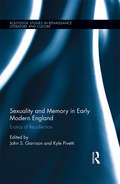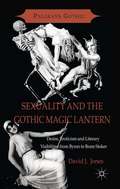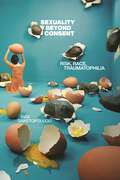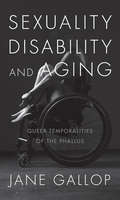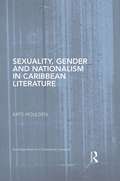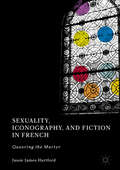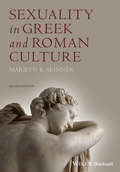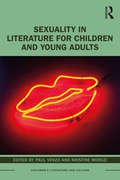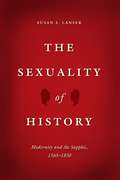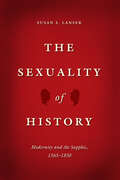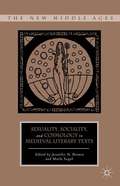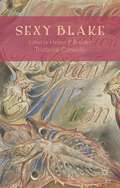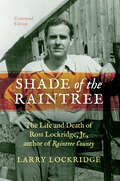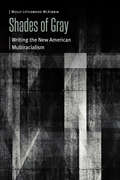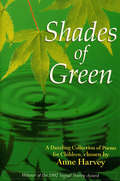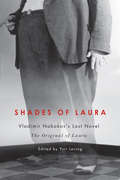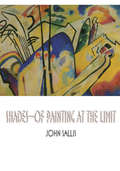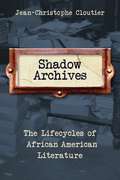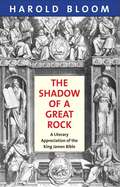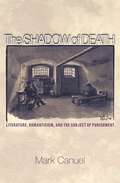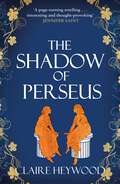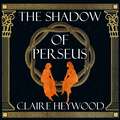- Table View
- List View
Sexuality and Memory in Early Modern England: Literature and the Erotics of Recollection (Routledge Studies in Renaissance Literature and Culture)
by John S. Garrison Kyle PivettiThis volume brings together two vibrant areas of Renaissance studies today: memory and sexuality. The contributors show that not only Shakespeare but also a broad range of his contemporaries were deeply interested in how memory and sexuality interact. Are erotic experiences heightened or deflated by the presence of memory? Can a sexual act be commemorative? Can an act of memory be eroticized? How do forms of romantic desire underwrite forms of memory? To answer such questions, these authors examine drama, poetry, and prose from both major authors and lesser-studied figures in the canon of Renaissance literature. Alongside a number of insightful readings, they show that sonnets enact a sexual exchange of memory; that epics of nationhood cannot help but eroticize their subjects; that the act of sex in Renaissance tragedy too often depends upon violence of the past. Memory, these scholars propose, re-shapes the concerns of queer and sexuality studies - including the unhistorical, the experience of desire, and the limits of the body. So too does the erotic revise the dominant trends of memory studies, from the rhetoric of the medieval memory arts to the formation of collective pasts.
Sexuality and the Gothic Magic Lantern
by David J. JonesThis fascinating study explores the multifarious erotic themes associated with the magic lantern shows, which proved the dominant visual medium of the West for 350 years, and analyses how the shows influenced the portrayals of sexuality in major works of Gothic fiction.
Sexuality Beyond Consent: Risk, Race, Traumatophilia (Sexual Cultures)
by Avgi SaketopoulouRadical alternatives to consent and traumaArguing that we have become culturally obsessed with healing trauma, Sexuality Beyond Consent calls attention to what traumatized subjects do with their pain. The erotics of racism offers a paradigmatic example of how what is proximal to violation may become an unexpected site of flourishing. Central to the transformational possibilities of trauma is a queer form of consent, limit consent, that is not about guarding the self but about risking experience. Saketopoulou thereby shows why sexualities beyond consent may be worth risking-and how risk can solicit the future.Moving between clinical and cultural case studies, Saketopoulou takes up theatrical and cinematic works such as Slave Play and The Night Porter, to chart how trauma and sexuality join forces to surge through the aesthetic domain. Putting the psychoanalytic theory of Jean Laplanche in conversation with queer of color critique, performance studies, and philosophy, Sexuality Beyond Consent proposes that enduring the strange in ourselves, not to master trauma but to rub up against it, can open us up to encounters with opacity. The book concludes by theorizing currents of sadism that, when pursued ethically, can animate unique forms of interpersonal and social care.
Sexuality, Disability, and Aging: Queer Temporalities of the Phallus
by Jane GallopDrawing on her own experiences with late-onset disability and its impact on her sex life, along with her expertise as a cultural critic, Jane Gallop explores how disability and aging work to undermine one's sense of self. She challenges common conceptions that equate the decline of bodily potential and ability with a permanent and irretrievable loss, arguing that such a loss can be both temporary and positively transformative. With Sexuality, Disability, and Aging, Gallop explores and celebrates how sexuality transforms and becomes more queer in the lives of the no longer young and the no longer able while at the same time demonstrating how disability can generate new forms of sexual fantasy and erotic possibility.
Sexuality, Gender and Nationalism in Caribbean Literature (Routledge Research in Postcolonial Literatures)
by Kate HouldenThis book focuses on sex and sexuality in post-war novels from the Anglophone Caribbean. Countering the critical orthodoxy that literature from this period dealt with sex only tangentially, implicitly transmitting sexist or homophobic messages, the author instead highlights the range and diversity in its representations of sexual life. She draws on gender and sexuality studies, postcolonial theory and cultural history to provide new readings of seminal figures like Samuel Selvon and George Lamming whilst also calling attention to the work of innovative, lesser-studied authors such as Andrew Salkey, Oscar Dathorne and Rosa Guy. Offering a coherent and expansive overview of how post-war Caribbean novelists have treated the persistently controversial topic of sex, this book addresses one of the blind spots in Caribbean literary criticism. It mines a range of little-studied archival materials and texts to argue that fiction of the post-war era exhibits both continuities with the sexual emphases of earlier writing and connections to later trends. The author also presents nationalist ideology as central to the literature of this era. It is in the fictional rendering of sexuality that the contradictions of the nationalist project are most apparent; sex both exceeds and threatens the imagined unity on which the political vision depends.
Sexuality, Iconography, and Fiction in French: Queering the Martyr
by Jason James HartfordThis book explores the modern cultural history of the queer martyr in France and Belgium. By analyzing how popular writers in French responded to Catholic doctrine and the tradition of St. Sebastian in art, Queering the Martyr shows how religious and secular symbols overlapped to produce not one, but two martyr-types. These are the queer type, typified first by Gustave Flaubert, which is a philosophical foil, and the gay type, popularized by Jean Genet but created by the Belgian Georges Eekhoud, which is a political and pornographic device. Grounded in feminist queer theory and working from a post-psychoanalytical point of view, the argument explores the potential and limits of these two figures, noting especially the persistence of misogyny in religious culture.
Sexuality in Greek and Roman Culture
by Marilyn B. SkinnerThis agenda-setting text has been fully revised in its second edition, with coverage extended into the Christian era. It remains the most comprehensive and engaging introduction to the sexual cultures of ancient Greece and Rome.Covers a wide range of subjects, including Greek pederasty and the symposium, ancient prostitution, representations of women in Greece and Rome, and the public regulation of sexual behaviorExpanded coverage extends to the advent of Christianity, includes added illustrations, and offers student-friendly pedagogical featuresText boxes supply intriguing information about tangential topicsGives a thorough overview of current literature while encouraging further reading and discussionConveys the complexity of ancient attitudes towards sexuality and gender and the modern debates they have engendered
Sexuality in Literature for Children and Young Adults (Children's Literature and Culture)
by Paul VenzoExpanding outward from previous scholarship on gender, queerness, and heteronormativity in children’s literature, this book offers fresh insights into representations of sex and sexuality in texts for young people. In this collection, new and established scholars examine how fiction and non-fiction writing, picture books, film and television and graphic novels position young people in relation to ideologies around sexuality, sexual identity, and embodiment. This book questions how such texts communicate a sense of what is possible, impossible, taboo, or encouraged in terms of being sexual and sexual being. Each chapter is motivated by a set of important questions: How are representations of sex and sexuality depicted in texts for young people? How do these representations affect and shape the kinds of sexualities offered as models to young readers? And to what extent is sexual diversity acknowledged and represented across different narrative and aesthetic modes? This work brings together a diverse range of conceptual and theoretical approaches that are framed by the idea of sexual becoming: the manner in which texts for young people invite their readers to assess and potentially adopt ways of thinking and being in terms of sex and sexuality.
Sexuality in Literature for Children and Young Adults (Children's Literature and Culture)
by Paul VenzoExpanding outward from previous scholarship on gender, queerness, and heteronormativity in children’s literature, this book offers fresh insights into representations of sex and sexuality in texts for young people. In this collection, new and established scholars examine how fiction and non-fiction writing, picture books, film and television and graphic novels position young people in relation to ideologies around sexuality, sexual identity, and embodiment. This book questions how such texts communicate a sense of what is possible, impossible, taboo, or encouraged in terms of being sexual and sexual being. Each chapter is motivated by a set of important questions: How are representations of sex and sexuality depicted in texts for young people? How do these representations affect and shape the kinds of sexualities offered as models to young readers? And to what extent is sexual diversity acknowledged and represented across different narrative and aesthetic modes? This work brings together a diverse range of conceptual and theoretical approaches that are framed by the idea of sexual becoming: the manner in which texts for young people invite their readers to assess and potentially adopt ways of thinking and being in terms of sex and sexuality.
The Sexuality of History: Modernity and the Sapphic, 1565-1830
by Susan S. LanserThe period of reform, revolution, and reaction that characterized seventeenth- and eighteenth-century Europe also witnessed an intensified interest in lesbians. In scientific treatises and orientalist travelogues, in French court gossip and Dutch court records, in passionate verse, in the rising novel, and in cross-dressed flirtations on the English and Spanish stage, poets, playwrights, philosophers, and physicians were placing sapphic relations before the public eye. In The Sexuality of History, Susan S. Lanser shows how intimacies between women became harbingers of the modern, bringing the sapphic into the mainstream of some of the most significant events in Western Europe. Ideas about female same-sex relations became a focal point for intellectual and cultural contests between authority and liberty, power and difference, desire and duty, mobility and change, order and governance. Lanser explores the ways in which a historically specific interest in lesbians intersected with, and stimulated, systemic concerns that would seem to have little to do with sexuality. Departing from the prevailing trend of queer reading whereby scholars ferret out hidden content in "closeted” texts, Lanser situates overtly erotic representations within wider spheres of interest. The Sexuality of History shows that just as we can understand sexuality by studying the past, so too can we understand the past by studying sexuality.
The Sexuality of History: Modernity and the Sapphic, 1565–1830
by Susan S. LanserThe period of reform, revolution, and reaction that characterized seventeenth- and eighteenth-century Europe also witnessed an intensified interest in lesbians. In scientific treatises and orientalist travelogues, in French court gossip and Dutch court records, in passionate verse, in the rising novel, and in cross-dressed flirtations on the English and Spanish stage, poets, playwrights, philosophers, and physicians were placing sapphic relations before the public eye. In The Sexuality of History, Susan S. Lanser shows how intimacies between women became harbingers of the modern, bringing the sapphic into the mainstream of some of the most significant events in Western Europe. Ideas about female same-sex relations became a focal point for intellectual and cultural contests between authority and liberty, power and difference, desire and duty, mobility and change, order and governance. Lanser explores the ways in which a historically specific interest in lesbians intersected with, and stimulated, systemic concerns that would seem to have little to do with sexuality. Departing from the prevailing trend of queer reading whereby scholars ferret out hidden content in “closeted” texts, Lanser situates overtly erotic representations within wider spheres of interest. The Sexuality of History shows that just as we can understand sexuality by studying the past, so too can we understand the past by studying sexuality.
Sexuality, Sociality, and Cosmology in Medieval Literary Texts
by Jennifer N. Brown Marla SegolThis edited volume contains nine articles exploring medieval sexuality and its relation to cosmological and social ordering. All of our authors analyze literary texts, both religious and secular, using a variety of critical methodologies. These include discourse theory, psychoanalytic criticism, queer theory, masculinity studies, and new historicist methodologies, among others. However, we all begin with the notion that medieval sexuality is distinct from our own conceptions of it, and that the one of the most important factors in considering its difference is its conceptualization in terms of social and cosmological ordering. Medieval people ordered their communities differently than contemporary people do, and they conceptualized their relationship to them based on different cosmological models that the ones we currently use. As a result, they thought of sexuality differently as well. This volume explores the relation between sexuality, social taxonomies, and cosmology in medieval religious and secular literature, as well as the various contemporary methodologies available for conceptualizing this. Its theoretical importance lies in this dual focus, which will render the collection useful to a wide audience of students and teachers of medieval literature, religion and history, as well as to those interested in the history of sexuality generally. "
Sexy Blake
by Helen P. Bruder Tristanne ConnollyThis book lays bare numerous sexy Blakes, arguing for both chastity and pornography, violence and domination as well as desire and redemption, and also journeying in the realms of conceptual sex and conceptual art. Fierce tussles over the body in, and the body of, the poet-artist's work celebrate Blakean attractions and repulsions.
Shade of the Raintree, Centennial Edition: The Life And Death Of Ross Lockridge, Jr. , Author Of Raintree County
by Larry LockridgeRaintree County, the first novel by Ross Lockridge, Jr., was the publishing event of 1948. Excerpted in Life magazine, it was a Book-of-the-Month Club Main Selection, won MGM's Novel Award and a movie deal, and stood at the top of the nation's bestseller lists. Unfortunately, Lockridge's first novel was also his last. Two months after its publication the 33-year-old author from Bloomington, Indiana, took his own life. His son Larry was five years old at the time. Shade of the Raintree is Larry's search for an understanding of his father's baffling act. In this powerfully narrated biography, Larry Lockridge uncovers a man of great vitality, humor, love, and visionary ambition, but also of deep vulnerability. The author manages to combine a son's emotional investments with a sleuth's dispassionate inquiry. The result is an exhilarating, revelatory narrative of an American writer's life. With a new preface by the author, this 2014 paperback edition marks 100 years since the birth of Ross Lockridge, Jr.
Shades of Gray: Writing the New American Multiracialism (Borderlands and Transcultural Studies)
by Molly Littlewood McKibbinIn Shades of Gray Molly Littlewood McKibbin offers a social and literary history of multiracialism in the twentieth-century United States. She examines the African American and white racial binary in contemporary multiracial literature to reveal the tensions and struggles of multiracialism in American life through individual consciousness, social perceptions, societal expectations, and subjective struggles with multiracial identity. McKibbin weaves a rich sociohistorical tapestry around the critically acclaimed works of Danzy Senna, Caucasia (1998); Rebecca Walker, Black White and Jewish: Autobiography of a Shifting Self (2001); Emily Raboteau, The Professor’s Daughter (2005); Rachel M. Harper, Brass Ankle Blues (2006); and Heidi Durrow, The Girl Who Fell from the Sky (2010). Taking into account the social history of racial classification and the literary history of depicting mixed race, she argues that these writers are producing new representations of multiracial identity.Shades of Gray examines the current opportunity to define racial identity after the civil rights, black power, and multiracial movements of the late twentieth century changed the sociopolitical climate of the United States and helped revolutionize the racial consciousness of the nation. McKibbin makes the case that twenty-first-century literature is able to represent multiracial identities for the first time in ways that do not adhere to the dichotomous conceptions of race that have, until now, determined how racial identities could be expressed in the United States.
Shades Of Green
by Anne HarveyA wide-ranging collection of nature poems for children, chosen by Anne Harvey. This is the perfect collection for introducing children to the magic of poetry. Includes poems from Thomas Hardy, Spike Milligan, Laurie Lee, Ian Serraillier, John Betjemen, William Blake, Geoffery Chaucer, Emily Dickinson, Philip Larkin, Helen Dunmore, and many more.
Shades of Laura
by Yuri LevingShortly before Vladimir Nabokov died in 1977, he left instructions that the draft for his last novel, The Original of Laura, be destroyed. But in 2008 Dmitri Nabokov, the writer's only child and sole surviving heir, contravened his father's wishes. Formed from novelistic fragments that had been hidden from the public eye for three decades, The Original of Laura is a construction based on the conjecture of the Nabokov estate, publishers, and scholars. Shades of Laura returns to the "scene of the crime," elucidating the process of publishing Nabokov's unfinished novel from its conception - the reproduction of 138 handwritten index cards - to the simultaneous publication of translations of the final text in several languages. The essays in this collection investigate the event of publication and reconstitute the book's critical reception, reproducing a selection of some of the most salient reviews. Critics condemned Dmitri's choice, but as contributors to this volume attest, there are many more "shades" and "nuances" to his decision. The book also endeavours to allow readers to understand and evaluate an incomplete novel; contributors analyze its plot, structure, imagery, and motifs. Published after prolonged public debate, Vladimir Nabokov's The Original of Laura was dubbed "the most eagerly awaited literary novel of this fledgling century." Covering the publication from a broad spectrum of perspectives, this collection reassesses the Nabokov canon and the roots of his literary prestige. Contributors include Paul Ardoin (Florida State University), Gennady Barabtarlo (University of Missouri), Brian Boyd (University of Auckland), Marijeta Bozovic (Colgate University), Maurice Couturier (University of Nice), Lara Delage-Toriel (Strasbourg University), Galya Diment (University of Washington), Leland de la Durantaye (Claremont McKenna College), Michael Juliar (Private collector), Eric Naiman (University of California, Berkeley), Ellen Pifer (University of Delaware), Anna Raffetto (Giulio Einaudi Publishing House, Turin), Michael Rodgers (University of Strathclyde), Rien Verhoef (Leiden University), Olga Voronina (Bard College), Tadashi Wakashima (Kyoto University), Michael Wood (Princeton University), and Barbara Wyllie (Slavonic and East European Review).
Shades of Laura: Vladimir Nabokov's Last Novel, The Original of Laura
by Yuri LevingShortly before Vladimir Nabokov died in 1977, he left instructions that the draft for his last novel, The Original of Laura, be destroyed. But in 2008 Dmitri Nabokov, the writer's only child and sole surviving heir, contravened his father's wishes. Formed from novelistic fragments that had been hidden from the public eye for three decades, The Original of Laura is a construction based on the conjecture of the Nabokov estate, publishers, and scholars. Shades of Laura returns to the "scene of the crime," elucidating the process of publishing Nabokov's unfinished novel from its conception - the reproduction of 138 handwritten index cards - to the simultaneous publication of translations of the final text in several languages. The essays in this collection investigate the event of publication and reconstitute the book's critical reception, reproducing a selection of some of the most salient reviews. Critics condemned Dmitri's choice, but as contributors to this volume attest, there are many more "shades" and "nuances" to his decision. The book also endeavours to allow readers to understand and evaluate an incomplete novel; contributors analyze its plot, structure, imagery, and motifs. Published after prolonged public debate, Vladimir Nabokov's The Original of Laura was dubbed "the most eagerly awaited literary novel of this fledgling century." Covering the publication from a broad spectrum of perspectives, this collection reassesses the Nabokov canon and the roots of his literary prestige. Contributors include Paul Ardoin (Florida State University), Gennady Barabtarlo (University of Missouri), Brian Boyd (University of Auckland), Marijeta Bozovic (Colgate University), Maurice Couturier (University of Nice), Lara Delage-Toriel (Strasbourg University), Galya Diment (University of Washington), Leland de la Durantaye (Claremont McKenna College), Michael Juliar (Private collector), Eric Naiman (University of California, Berkeley), Ellen Pifer (University of Delaware), Anna Raffetto (Adelphi Publishing House, Milan), Michael Rodgers (University of Strathclyde), Rien Verhoef (Leiden University), Olga Voronina (Bard College), Tadashi Wakashima (Kyoto University), Michael Wood (Princeton University), and Barbara Wyllie (Slavonic and East European Review).
Shades—Of Painting at the Limit
by John Sallis"[Sallis’s] ideas are presented in a singular, scholarly, remarkable, captivating, conceptually rigorous, dense, and deep manner.... Highly recommended." —Choice"This fascinating book by one of the more original voices writing philosophy in English poses questions about the nature of the visible and invisible, sensible and intelligible." —Dennis SchmidtWhat is it that an artist paints in a painting? Working from paintings themselves rather than from philosophical theories, John Sallis shows how, through shades and limits, the painter renders visible the light that confers visibility on things. In his extended examination of three phases in the development of modern painting, Sallis focuses on the work of Claude Monet, Wassily Kandinsky, and Mimmo Paladino—three painters who, each in his own way, carry painting to the limit.
Shadow Archives: The Lifecycles of African American Literature
by Jean-Christophe CloutierRecasting the history of African American literature, Shadow Archives brings to life a slew of newly discovered texts—including Claude McKay’s Amiable with Big Teeth—to tell the stories of black special collections and their struggle for institutional recognition. Jean-Christophe Cloutier offers revelatory readings of major African American writers, including McKay, Richard Wright, Ann Petry, and Ralph Ellison, and provides a nuanced view of how archival methodology, access, and the power dynamics of acquisitions shape literary history.Shadow Archives argues that the notion of the archive is crucial to our understanding of postwar African American literary history. Cloutier combines his own experiences as a researcher and archivist with a theoretically rich account of the archive to offer a pioneering study of the importance of African American authors’ archival practices and how these shaped their writing. Given the lack of institutions dedicated to the black experience, the novel became an alternative site of historical preservation, a means to ensure both individual legacy and group survival. Such archivism manifests in the work of these authors through evolving lifecycles where documents undergo repurposing, revision, insertion, falsification, transformation, and fictionalization, sometimes across decades. An innovative interdisciplinary consideration of literary papers, Shadow Archives proposes new ways for literary scholars to engage with the archive.
The Shadow Negotiation: How Women Can Master the Hidden Agendas That Determine Bargaining Success
by Deborah M. Kolb Judith WilliamsWomen have to negotiate not harder, but smarter.
The Shadow of A Great Rock: A Literary Appreciation of the King James Bible
by Harold BloomThe King James Bible stands at "the sublime summit of literature in English," sharing the honor only with Shakespeare, Harold Bloom contends in the opening pages of this illuminating literary tour. Distilling the insights acquired from a significant portion of his career as a brilliant critic and teacher, he offers readers at last the book he has been writing "all my long life," a magisterial and intimately perceptive reading of the King James Bible as a literary masterpiece. Bloom calls it an "inexplicable wonder" that a rather undistinguished group of writers could bring forth such a magnificent work of literature, and he credits William Tyndale as their fountainhead. Reading the King James Bible alongside Tyndale's Bible, the Geneva Bible, and the original Hebrew and Greek texts, Bloom highlights how the translators and editors improved upon--or, in some cases, diminished--the earlier versions. He invites readers to hear the baroque inventiveness in such sublime books as the Song of Songs, Ecclesiastes, and Job, and alerts us to the echoes of the King James Bible in works from the Romantic period to the present day. Throughout, Bloom makes an impassioned and convincing case for reading the King James Bible as literature, free from dogma and with an appreciation of its enduring aesthetic value.
The Shadow of Death: Literature, Romanticism, and the Subject of Punishment
by Mark CanuelThe Shadow of Death is a timely and ambitious reassessment of English Romantic literature and the unique role it played in one of the great liberal political causes of the modern age. Mark Canuel argues that Romantic writers in Great Britain led one of the earliest assaults on the death penalty and were instrumental in bringing about penal-law reforms. He demonstrates how writers like Percy Bysshe Shelley, Lord Byron, William Wordsworth, and Jane Austen defined the fundamental contradictions that continue to inform today's debates about capital punishment. Celebrated reformers like Sir Samuel Romilly and William Ewart campaigned against the widespread use of death to punish crimes ranging from murder to petty theft, but they were most influential for initiating a system of penalties built upon conflicting motivations and justifications. Canuel examines the ways Romantic poets and novelists magnified these tensions while treating them as uniquely aesthetic opportunities, seized upon contending rationales of punishment to express imaginative power, and revealed how the imagination fueled the new penal code's disturbing vitality. Death-penalty reform, Canuel argues, in fact emerged from a new way of thinking about punishment as a negotiation among rationales rather than a seamless whole, with leniency and severity constantly at odds. He concludes by exploring how Romantic penal reform continues to influence contemporary views about the justice--and injustice--of legal sanctions.
The Shadow of Perseus
by Claire HeywoodHistory remembers him as a hero. But the women who knew him best remember a different man...Perseus grows up wanting to be a hero, but he cannot become one if his mother Danae still sees him as a boy. When his stepfather Polydektes casts him away on a voyage across the sea, Perseus is determined to fulfil the great destiny of the son of a god and the grandson of a king. But the line between heroism and monstrosity is thin, and when Perseus attempts to seduce first gentle Medusa and then beautiful Andromeda, before finally reuniting with Danae, they each learn of the dangers of resisting a boy prepared to risk it all for greatness . . .
The Shadow of Perseus: A compelling feminist retelling of the myth of Perseus told from the perspectives of the women who knew him best
by Claire HeywoodThe myth of Perseus, told through the story of the three women who knew him best - his mother Danae, his wife Andromeda, and his victim, Medusa.History remembers him as a hero. But the women who knew him best remember a different man...Perseus grows up wanting to be a hero, but he cannot become one if his mother Danae still sees him as a boy. When his stepfather Polydektes casts him away on a voyage across the sea, Perseus is determined to fulfil the great destiny of the son of a god and the grandson of a king. But the line between heroism and monstrosity is thin, and when Perseus attempts to seduce first gentle Medusa and then beautiful Andromeda, before finally reuniting with Danae, they each learn of the dangers of resisting a boy prepared to risk it all for greatness . . .(p) 2023 Hodder & Stoughton Limited
